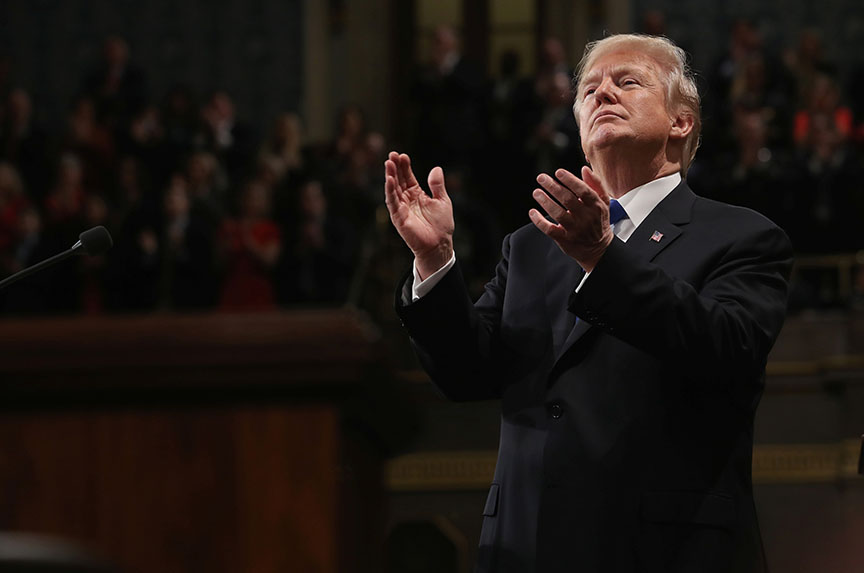
Touted as a speech of unity, US President Donald J. Trump’s first State of the Union address is likely to do little to mend the divisions and gridlock in Washington.
The speech on January 30 did reflect the maturation of Trump in the role of president along with that of his administration. It was a more even, sophisticated, and coherent speech than the one he gave as a political rookie to a joint session of Congress last year. This was a reflection of the firm hand of White House Chief of Staff John Kelly as well as the departure of some of the polarizing and divisive personalities that had previously occupied the White House. But it also contained a fierce and combative restatement by the president of many campaign themes that sets clear battle lines for the year ahead.
In many ways, this was a conventional State of the Union speech. Trump touted the successes of the past year, laid out several priorities for the year ahead, and celebrated stories of American strength in the face of adversity. The speech even struck a rare optimistic tone about the current and future state and of the United States. The president touted the strength of the economy, low unemployment numbers, job creation by large corporations, and the return of manufacturing jobs as a result of tax cuts as well as the resilient responses by Americans to the many recent natural disasters.
The president called for leaders to “set aside differences” and work together to achieve results for the American people. Indeed, the speech included several surprising themes and proposals that would appeal to liberals. These included paid family leave, increased vocational training for future jobs, and prison reform. The proposals to rebuild national infrastructure, respond to the opioid epidemic, and lower the price of prescription medication should broadly appeal to both parties.
But the president’s critics are unlikely to be moved. For one, it will be pointed out that many of the successes for which he claimed responsibility, including the strong economy and the defeat of the Islamic State of Iraq and al-Sham (ISIS), are long-running trends resulting from decisions and action taken by the Obama administration.
Critics will also wonder whether the president really believes the message he delivered. They will point out that the speech contained little vision or plans for how Trump will achieve his goals, and that he had done little to date to address many of these issues during the first year of his administration.
Others will point out that the tone of the speech was incongruous with that of the president’s daily tweets and speeches, a sense that was reinforced by unsubtle references in the address to ongoing personal feuds and language intended to prickle his opponents.
The president’s base, however, will be most excited by the speech. The address was built around a more sophisticated evolution of Trump’s polarizing campaign platform. Familiar themes were delivered in a more refined and politically adept manner, but there was no mistaking them. Many of the comments were clearly intended to challenge and inflame Trump’s political opponents while invigorating his base. In particular, the president defiantly and combatively laid out his position on the contentious issues of immigration and border security. Despite calling for compromise, it was clear he had little intent to do so.
Conventional conservatives will likely also be encouraged by the speech, and it may solidify Trump’s support among more moderate and “establishment” Republicans.
On balance, much of the speech could have been delivered by any conventional conservative president: it was heavy on themes such as a focus on family values, religion, and tax cuts as well as the roll back of regulations and public health care. There were allusions to a bygone era and “rediscovering the American way,” punctuated by claims of a renewal of the manufacturing and coal industries in America, and the appointment of federal judges who will “interpret the Constitution as written.”
Foreign policy and defense issues got little attention. What wasn’t said was almost as revealing as what was. America’s ongoing military operations got barely a mention beyond hailing the defeat of ISIS and loosening of rules of engagement. Beyond calls to fully fund the Defense Department, and ubiquitous worship of American veterans, there were few foreign policy priorities laid out and fewer plans to achieve them.
The president called for a rebuilding of the nuclear arsenal as a deterrent, noted his earlier recognition of Jerusalem as the capital of Israel, spoke of the need for “peace through strength,” and reiterated his support for the uprisings in Iran. But despite the focus in the recently released National Defense Strategy on a resurgence of great power competition, there was little mention either China or, more pointedly, Russia. The president did linger on the issue of North Korea, however, and seemed to be laying a public case for military action there in the near future.
Trump’s first State of the Union was well structured and delivered in a measured and disciplined way. Despite his calls for unity and to put politics aside, it was clearly intended to do the very opposite. In an election year, what it will do is invigorate his supporters and antagonize his opponents.
John Watts is a senior fellow in the Atlantic Council’s Scowcroft Center on Strategy and Security. Follow him on Twitter @John_T_Watts.
Image: US President Donald J. Trump applauded during his first State of the Union address to a joint session of Congress in Washington on January 30. (Reuters/Win McNamee)

